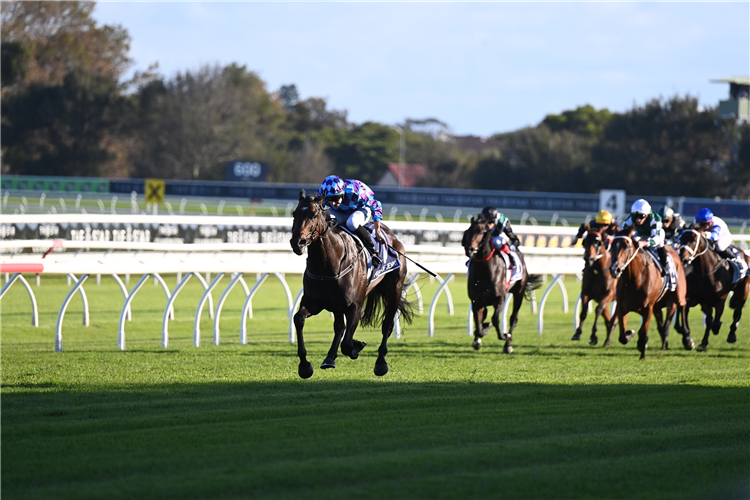3 minute read
Racing and Sports' handsome handicapper Adam Blencowe runs the rule over Pride Of Jenni, her rating and her place in the world ahead of this weekend's Makybe Diva Stakes at Flemington.

Racing and Sports' award-winning* podcast, the Punters Preamble, typically kickstarts with host Simon saying, 'gee it's a massive weekend ahead in racing' and then we move on to discussing the highest rated horse participating in said 'massive weekend'.
This weekend (really) is a massive weekend. It includes the sports oldest Classic, the St Leger at Doncaster, Arc Trials in France and Irish Champions weekend, where six of the 13 Group One races run in Ireland take place across two days at Leopardstown and the Curragh including the jewel in that crown – the Irish Champion Stakes.
So how could Racing and Sports and their merry band of handicappers throw up Pride Of Jenni as the top rated horse racing this weekend? She's not favourite (she never is) in a faux Group One in Melbourne having been dropkicked through the back of the telly in another faux Group One last time. Meanwhile Auguste Rodin defends his Irish Champion Stakes against a soon-to-be superstar in Economics and a Japanese Derby runner-up. The great Kyprios runs on Sunday and the Arc trials feature clashes that will have me joy-pouring Burgundy wearing nothing but a beret late into Sunday night.
If the ratings don't give us the answer that we want, we have two options:
1/ Rage against the ratings, send me an angry tweet explaining that I don't know what I am doing, and declare the entire exercise a pointless, abstract nonsense.
Or 2/ We can consider the question that we are asking of the ratings and the question that they are attempting to answer. What really is a ratings model?
One analogy would be to see a ratings model as a map and I as a handsome traveller and cartographer.
Maps are a necessary simplification of the area that they seek to describe. In that simplification detail is inevitably lost as the cartographer chooses the map's primary focus. This is why two maps/models of the same area can look very different.
A map of London focused on the roads looks very different to a map of the London Underground or one focused on the canals and waterways, but all are true representations of London.
We can build maps and models in 2D, 3D, 4D and beyond. None are as complete as the reality they represent but their simplification makes them useful.
The model we use for the Punters Preamble is the TWAT Model – often (in more official settings) referred to as RAS Ratings.
A TWAT is not just the handicapper/cartographer/designer at the helm but also a (very funny) acronym for 'Timeform With A Twist' as it uses the Timeform scale as a base before twisting a few parameters to make them more user friendly for users both human and computer.
These twists include a change to the weight-for-age scale and a change to the assumptions about the value of the lapses of time between runners in a race. Simply put, the value of final margins.
1.14 seconds lapsed in between Jenni and Via Sistina crossing the finish line in the QEII at Randwick. The TWAT model describes that as a difference of 11lbs.
But this map is very much focused on what happened rather than how it happened. Pride Of Jenni went into the QEII rated 127 and Via Sistina 123 – how did it come about that 1.14 seconds – or 11lbs – would separate them at the finish? In atypical fashion, is the answer to that one. Jenni ran 2000m by running the first 1400m in 72.52 seconds then 49.52 seconds to home. Via Sistina ran 78.28 then 44.90. Seriously!
Yes, seriously Darren… Via Sistina covered her last 400m more than three full seconds faster than Jenni and still finished 1.14 seconds behind her. She packed far too much of her power into far too smaller portion of the race. As J-Mac beautifully summarised it: embarrassing.
But the TWAT model is focused on the 1.14. Another model, focused more on the 'embarrassing' how than simply the what could describe the same event very differently. One such model, kept under lock and key at R&S HQ, would go as far as describing Via Sistina as the better horse – if not by much – on the day.
The TWAT model stands firm though. Jenni was the better horse - she won the race and by miles!
Better than Via Sistina perhaps, but here we are claiming that it was better than the best (to date) of anything running in Europe on this wild weekend. There are many runners engaged in Ireland and France (even England) that conventional wisdom (even my own perhaps slightly unconventional version of wisdom) would consider better than Pride Of Jenni – but do any of them own a better single piece of form?
Picking out each little formline would take this from a long ramble to a completely unreadable one but lets just tug one thread to get an idea of where it takes us:
Via Sistina is a Group One winner in Ireland who ran her best race when second in the Champion Stakes at Ascot – a rating of 123 which she is yet to match in three runs down under.
Horizon Dore was third and has since filled the same slot behind Auguste Rodin at Royal Ascot. He also ran second to Mqse De Sevigne - as did Via Sistina who started clear favourite against her.
Mqse De Sevigne was landing her second Group One that day and has added three more since with the only horse to beat her in over 12 months being Inspiral who was herself in the middle of a Group One hattrick.
English punters had earlier sent Via Sistina out as an even-money chance against 4-1 Nashwa – essentially 70/30 – who won there and went on to run second in the International at York and half a length a way from Luxembourg and Auguste Rodin when third in the Irish Champion.
A further 1.1 seconds covered Via Sistina and the next five home in the QEII. Seventh was Place Du Carrousel – a Prix l'Opera winner on Arc Day 2022 (beating Nashwa) and also a winner on this weekend last year when taking the Prix Foy from the wonderful Iresine.
Global lines extend through Mr Brightside; some 14lbs away from Pride Of Jenni having been whiskers from Romantic Warrior in the only other (real) Group One over ten furlongs in Australia. Below his best they said. Perhaps. But by how far? It would not make mathematical sense for it to be much given other results… But we are getting into the weeds now…
One of the quirks of all of this is that I, your guide, the Virgil to your Dante, think Pride Of Jenni is going to get cartwheeled again on the weekend and would need ludicrous prices to even entertain backing her in the Irish Champion.
A large part of the reason for this (for the handful of time wasters that are still with me, I am drawing this to a close…) is that, as good punters well know, horses are much more than just their peak rating.
How often they produce that peak rating is a big part of the puzzle. Auguste Rodin has a hot-and-cold reputation but what we might call his 'peak ratio' – the rate that he runs to a new or prior peak rating – is 57.1% across 14 starts. Across her past 14 starts, a sample that conveniently fits the new Jenni – the time when dog became wolf – POJ has a peak ratio of 42.8%.
As a simple thought experiment – two ratings of 126 win just as often in a randomly drawn head-to-head as 129 -120.
Jenni can produce the weird and the wonderful but she operates on a highwire and can fall at any time. That is why she is great for the game and I look forward to her going one way or the other on Saturday.
*The Punters Preamble was the winner of the best new talent, most articulate podcaster, best Greek podcaster, and best new racing podcast at the (soon to be) annual RAS Podcast Awards (RPA) 2023.







